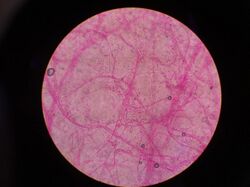Physics:Lactofuchsin mount
A Lactofuchsin mount (also spelled Lacto-fuchsin or Lacto-Fuchsin) is a technique used for mounting fungi with hyphae on a microscope slide for examination.[1] The main advantage of a lactofuchsin mount is that if performed correctly, it preserves the structure and arrangement of any hyphae that are present.
Advantages
To examine the hyphae of fungi under a microscope, a wet mount is essential. While this is possible to do with a water based mount, a better result can be obtained with lactofuchsin mounting fluid, which both sticks to the cell walls and colours the cell walls red in the process. Lactofuchsin, a 1% solution of basic fuchsine in lactic acid,[2] dries much slower than water, so the slide may be preserved for a longer period, particularly if the edges of the finished slide are sealed, for example with clear nail polish.[3] In addition, the refractive index of the fluid is significantly different to that of the cell walls, which provides a stronger visual contrast of the cell walls against the background.
Disadvantages
A significant disadvantage of Lactofuchsin is its cost; prices are over US$100 for a small 20mL bottle. Only a few drops are used for each mount. Lactofuchsin is poisonous.
References
- ↑ Harris, James L. (December 2000). "Safe, Low-Distortion Tape Touch Method for Fungal Slide Mounts". Journal of Clinical Microbiology 38 (12): 4683–4684. doi:10.1128/JCM.38.12.4683-4684.2000. PMID 11203439.
- ↑ HealthLink. "Lactofuchsin MSDS". http://healthlinkinc.net/MSDS/LactoFuchsin.pdf.
- ↑ "Moulds under the microscope". Moulds: their isolation, cultivation, and identification. New Brunswick Museum. http://website.nbm-mnb.ca/mycologywebpages/Moulds/Examination.html. Retrieved 19 March 2012.
 |


